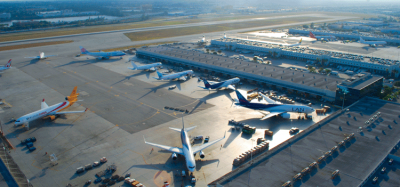Regulating dangerous goods
- Like
- Digg
- Del
- Tumblr
- VKontakte
- Buffer
- Love This
- Odnoklassniki
- Meneame
- Blogger
- Amazon
- Yahoo Mail
- Gmail
- AOL
- Newsvine
- HackerNews
- Evernote
- MySpace
- Mail.ru
- Viadeo
- Line
- Comments
- Yummly
- SMS
- Viber
- Telegram
- Subscribe
- Skype
- Facebook Messenger
- Kakao
- LiveJournal
- Yammer
- Edgar
- Fintel
- Mix
- Instapaper
- Copy Link
Posted: 11 September 2006 | David Brennan, Assistant Director – Special Cargo Standards, International Air Transport Association (IATA) | No comments yet
On the face of it, transporting dangerous goods by air, particularly on passenger aircraft would appear to be counter intuitive. The reality is that regulations for the air transport of dangerous goods have been in place for over 50 years.
On the face of it, transporting dangerous goods by air, particularly on passenger aircraft would appear to be counter intuitive. The reality is that regulations for the air transport of dangerous goods have been in place for over 50 years.
The International Air Transport Association (IATA) first developed regulations addressing the international air transport of dangerous goods as the “Restricted Articles Regulations” (RAR) in 1956, in response to demand from airlines and industry. As part of the industrial expansion following WWII, industry had a need to move chemicals, many of which were dangerous goods, quickly, and air transport met that need. The airlines had two objectives: safety and a consistent standard.
Safety was paramount to ensure that passengers were not put at risk, as at that time there were very few dedicated cargo aircraft and therefore most shipments of dangerous goods were transported on passenger aircraft. There was also a need for defined standards, such that dangerous goods shipments anywhere in the world, provided that they complied with the regulations, would be accepted and that having been accepted by one airline could be transhipped to another.
The IATA Restricted Articles Regulations became the Dangerous Goods Regulations (DGR) in 1984, when the International Civil Aviation Organization (ICAO) assumed responsibility for the regulation of dangerous goods in air transport through the Technical Instructions for the Safe Transport of Dangerous Goods by Air (Technical Instructions). IATA, in conjunction with member airlines comprising the Dangerous Goods Board, continued development of the DGR as the recognised field guide for the transport of dangerous goods by air. It did so by incorporating industry standard practices and operational requirements that enhanced safety and assisted in facilitating the transport of dangerous goods.
The standards achieved in the dangerous goods regulations can be demonstrated by the fact that there has not been any significant aircraft accident attributable to dangerous goods in the 50 years since the IATA Regulations first appeared, where the shipment of dangerous goods was prepared in accordance with the regulatory requirements. Unfortunately, there have been a number of aircraft accidents, such as ValuJet, which occurred in 1996, where dangerous goods were involved. However, in all of these accidents, the cause was not the dangerous goods per se but rather non-compliance with the regulations.
Current Regulations
While the dangerous goods regulations have evolved significantly since 1956, the fundamental principles remain unchanged. These principles include:
- All persons involved in shipping and transporting dangerous goods must have appropriate training;
- Shippers (consignors) are responsible for compliance with the regulations, which includes the correct classification, packaging, marking, labelling and documentation of the dangerous goods;
- For air transport, airline personnel are required to use a checklist to validate, to the extent possible, that the dangerous goods shipment meets the regulatory requirements.
One aspect of the dangerous goods regulations that has undergone a fundamental change is the recognition that the regulations for all modes of transport should be harmonised as far as possible. Having harmonised regulations helps shippers comply by removing inconsistencies that could lead to inadvertent breaches.
The United Nations Subcommittee of Experts on the Transport of Dangerous Goods (UN Subcommittee) have largely driven these harmonisation efforts through the development of the UN Recommendations on the Transport of Dangerous Goods (Model Regulations). The UN Recommendations now form the basis for the international modal regulations (ICAO Technical Instructions, International Maritime Organization [IMO] International Maritime Dangerous Goods Code and European Agreement Concerning the International carriage of Dangerous Goods by Road [ADR]) and many national road and rail dangerous goods transport regulations.
The harmonisation efforts of the UN Subcommittee do not mean that the provisions applicable to one mode of transport can be applied to all other modes. Air transport, by its nature, is more conservative when it comes to the transport of dangerous goods. There are many dangerous goods that may be shipped by road or sea that are not permitted on an aircraft. Other dangerous goods, whilst permitted for transport on a cargo aircraft cannot be transported on a passenger aircraft. For this reason the ICAO Dangerous Goods Panel (DGP) in developing the Technical Instructions, reviews the changes in the UN Model Regulations to ensure their appropriateness for air transport.
In addition, the ICAO DGP also considers specific proposals to improve the safety of dangerous goods transportation in air transport. In this respect, IATA and the IATA DGB work closely with the ICAO DGP to develop improvements to the regulations and to ensure that proposals reflect and address operational practices. One recent change to the ICAO Technical Instructions and IATA Dangerous Goods Regulations has been the move to address the safety risk posed by undeclared dangerous goods shipments.
This was done by adding “recognition of undeclared dangerous goods” as an element to dangerous goods training programmes for all categories of personnel. At the same time, employees of “freight forwarders” were specifically identified as being subject to dangerous goods training. This addressed two key elements:
- the majority of dangerous goods incidents are caused by spills, leaks and fires from items declared as “general cargo”;
- almost all general cargo transported by air is first processed by a freight forwarder and much of that is presented to the airline pre-built in an aircraft unit.
Requiring dangerous goods training to include recognition of what items could contain dangerous goods and then mandating that employees of freight forwarders receive such training, will help to detect undeclared dangerous goods before they get to the airline. That, in turn, will reduce the likelihood of dangerous goods incidents and accidents and therefore improve safety.
Having dangerous goods regulations as contained in the ICAO Technical Instructions and IATA DGR is one thing, but safety is not achieved just through the publication of regulations. Safety is only achieved when all participants in the transport chain are aware of and comply with the requirements in the regulations. Compliance is achieved when countries enact legislation that adopt or incorporate the requirements of the ICAO Technical Instructions. They must also have the required oversight and enforcement personnel to ensure that shippers, freight forwarders and operators are meeting those requirements.
Changes for 2007
The next round of changes to the regulations will take effect from 1st January 2007. Many of the changes are being driven by industry to ensure that appropriate regulations are in place to address new technologies. Of these, fuel cell technology for consumer electronic devices has emerged as an item that the air mode will have to address in the dangerous goods regulations. The 14th revised edition of the UN Model Regulations includes a new entry for “Fuel cell cartridges, containing flammable liquids”. This entry will be included into the 2007-2008 edition of the ICAO Technical Instructions and the 2007 IATA DGR, and will include the testing and packaging requirements applicable to the transport of methanol fuel cells. In addition, the 2007 regulations will include allowance for certain types of fuel in fuel cell cartridges powering consumer electronic devices, when in passenger carry-on baggage.
Since the 14th revised edition of the UN Model Regulations was finalised, additional fuel cell technologies have emerged, including fuel cells using hydrogen in a metal hydride, sodium borohydride and formic acid. The focus of all of these new technologies is the consumer electronics market. While the fuel cell industry certainly wants to be able to transport these by air as cargo, it is their carriage as part of passenger baggage that is the real objective. These new fuel cells will be marketed as an adjunct to the existing lithium ion batteries that are used to power laptop computers, mobile phones and other consumer devices. The advantage of fuel cells is that they do not need recharging like a battery and can be changed while the device is operating.
The challenge for the ICAO Dangerous Goods Panel and IATA Dangerous Goods Board is to ensure that there is sufficient detail available to consumers on each device, to easily determine its suitability for carriage as part of passenger carry-on baggage, as well as to adopt provisions to ensure their safe and speedy transport as cargo.
Future Considerations
As part of its five-pronged Simplifying the Business initiative, in 2006 IATA’s Board of Governors mandated the IATA e-freight project – designed to free cargo processes of paper from air cargo transportation by 2010 – with a “fast-track” programme to accommodate those parties that are able to free their supply chain processes from paper by 2007.
The case for IATA e-freight is clear as the industry simplifies to reduce costs and gain a further competitive edge over other modes of transportation by reducing the time needed to move cargo to its destination. Air cargo processes are complex and involve many participants.
In an e-freight world, dangerous goods consignments will require a robust solution. Currently, the shipper is required to provide a dangerous goods transport document, the IATA Shipper’s Declaration for Dangerous Goods, which describes in detail exactly what dangerous goods are being shipped, the quantity, number and type of packages. The airline transporting the dangerous goods consignment has a legal obligation to use an acceptance checklist to validate, to the extent possible, that the consignment is in compliance with all regulatory requirements.Having accepted the consignment, the airline then has to provide detailed information to the Pilot-in-Command for use in the event of an emergency in flight.
At the present time, the majority of this process is paper-based and requires freight forwarder, ground handling agent and airline employees to transcribe the data into various systems. IATA e-freight offers significant opportunities to reduce both the cost and time of accepting a dangerous goods consignment.
The challenge will be to engage with all parts of the transport chain – shippers, freight forwarders, airlines and government authorities – to ensure that the required information is available, that the information is protected from unauthorised use or misuse and that the standards set for this information allow the use of both existing and future systems.
David Brennan
David Brennan joined IATA in May 2002 and is currently the Assistant Director, Special Cargo Standards, with responsibility for the suite of IATA Dangerous Goods Products and Services. David is also the Panel member nominated by IATA to the International Civil Aviation Organization (ICAO) Dangerous Goods Panel.
Before joining IATA, he worked for Australia Post as a consultant on Aviation Security/Dangerous Goods compliance. Prior to that, David worked for Ansett Australia for a period of 26 years, most recently as Corporate Advisor, Dangerous Goods Compliance.
In that role, he attended meetings of the IATA Dangerous Goods Board on behalf of Ansett, meetings of the ICAO Dangerous Goods Panel as an industry advisor to the Australian representative and was a member and past Chairman of the Australian Dangerous Goods Air Transport Council.


















